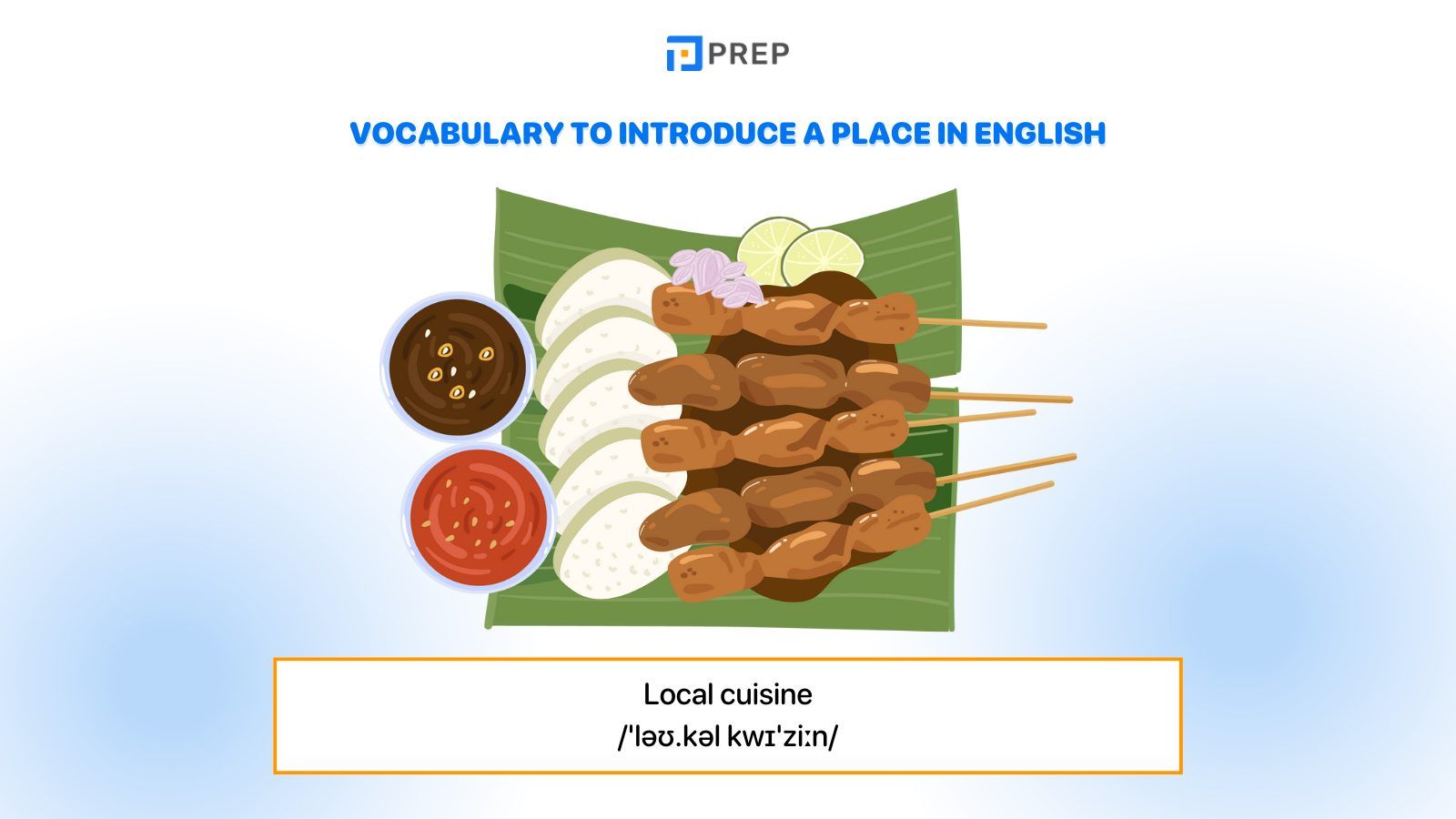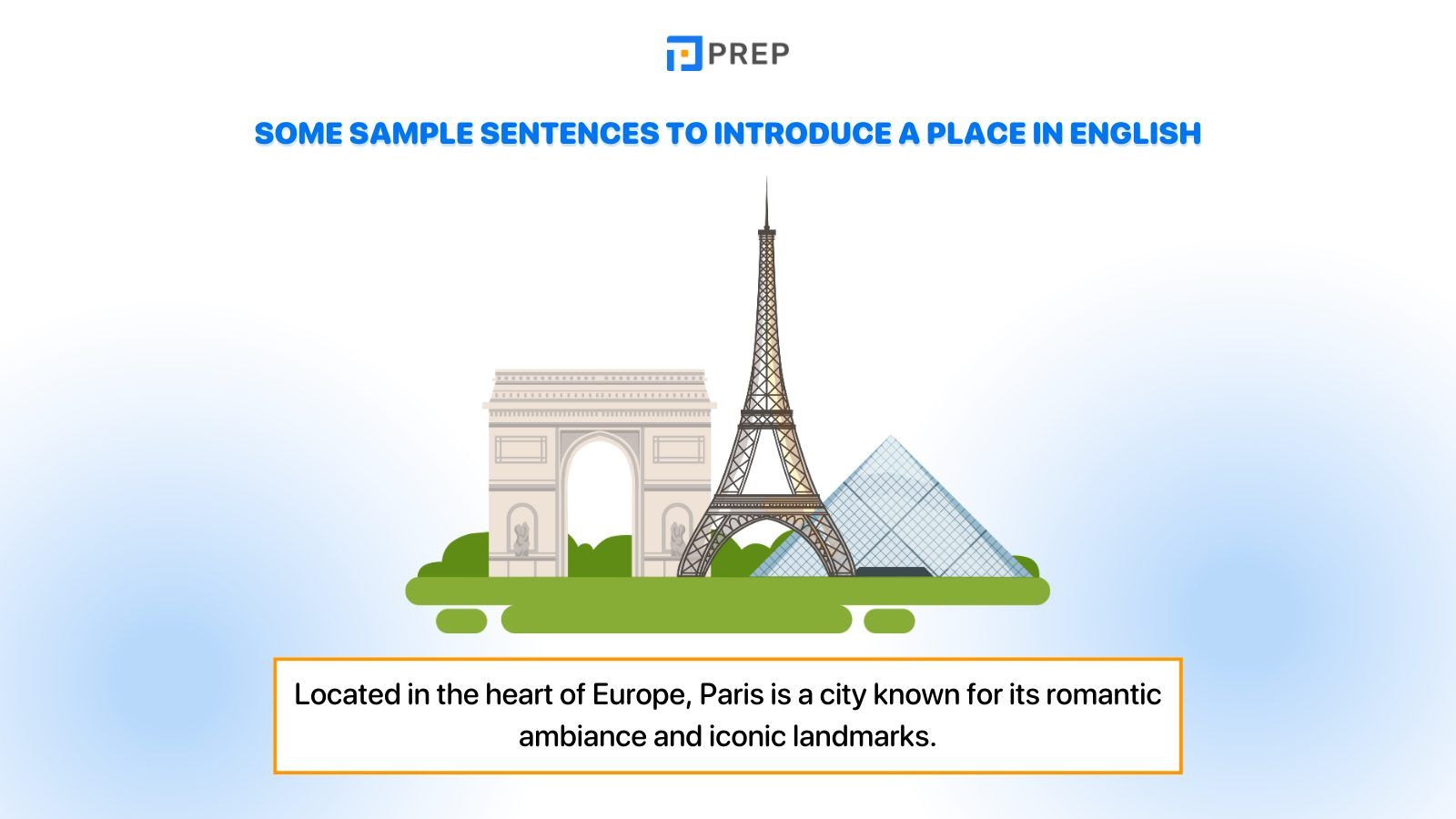Introduce a Place in English: Guide, Tips, and Examples
Wondering how to introduce a place in English effectively? This guide explains step-by-step structures, useful vocabulary, and common mistakes to avoid. You’ll also find sample paragraphs, exam applications, and practice resources to boost your speaking and writing confidence.

I. How to Introduce a Place in English Effectively
Introducing a place in English requires more than just listing its name or location. To make your description effective, especially in speaking or writing tasks, you need to organize your ideas clearly, use descriptive language, and express personal impressions naturally. This section will guide you through the key elements that make your introduction more engaging and fluent.
1. Basic Structure
To introduce a place effectively in English, it's important to follow a clear, logical structure. This not only helps the listener or reader follow your ideas easily but also allows you to organize your thoughts more confidently—especially in speaking tests or written tasks. A basic structure typically includes three key parts:
1. Introduction
- Start with the name of the place and general location (city, country, region).
- You can also mention how you know this place, or why it is important to you.
- Example: “Today, I’d like to introduce Da Lat, a peaceful city located in the Central Highlands of Vietnam.”
2. Main Description
- Provide specific details about the place, such as:
- Nature, architecture, activities, people, food, or notable landmarks
- Its vibe or atmosphere (busy, quiet, relaxing, touristy...)
- Include reasons why it stands out or what makes it special.
- Example: “The city is surrounded by pine forests and famous for its cool weather and colorful flower gardens.”
3. Personal Impression or Closing Comment
- Share your feelings or thoughts about the place
- You can mention a memorable experience there or explain why you would recommend it
- Example: “Whenever I visit, I feel refreshed and relaxed. It's definitely a place worth experiencing at least once.”
Following this simple structure helps you stay focused and create a more vivid, engaging introduction—whether you’re speaking in an exam or writing in class. To practice this structure with a familiar topic, explore Talk about your hometown.

2. Useful Vocabulary and Expressions
Using precise vocabulary and natural expressions is key to making your introduction more engaging and fluent. The right words can help your listener or reader visualize the place more clearly and feel your connection to it. Below are some useful language tools to help you do that:
Adjectives to Describe Places
|
Category |
Useful Adjectives |
|
Appearance |
charming, picturesque, scenic, peaceful, vibrant, quiet, modern, historic, traditional, cozy |
|
Size / Layout |
spacious, narrow, compact, wide-open, well-organized, crowded, dense |
|
Condition / Quality |
clean, well-maintained, polluted, dusty, run-down, messy, well-kept |
|
Color / Atmosphere |
colorful, bright, gloomy, foggy, sunny, dimly-lit, airy, warm, fresh |
|
Feeling / Mood |
lively, relaxing, romantic, welcoming, inviting, energetic, peaceful, noisy, hectic, cheerful |
|
Cultural Aspects |
ancient, artistic, multicultural, spiritual, historic, colonial, modernized, festive |
|
Function / Use |
residential, commercial, touristic, industrial, educational, religious, governmental, recreational |
Key Nouns and Phrases
|
Type |
Examples |
|
Place Types |
city, town, village, neighborhood, suburb, countryside, province, capital |
|
Features |
mountain range, river, beach, lake, forest, valley, coastline |
|
Man-Made Sites |
cathedral, museum, market, square, temple, bridge, landmark, attraction |
|
Activities |
sightseeing, street food, hiking trail, night market, cultural festival |
|
Descriptive Nouns |
location, destination, attraction, area, site, scenery, view, skyline, atmosphere |
Tips for learners:
- Try combining adjectives + nouns for natural expressions:
- a vibrant cultural destination
- a peaceful mountain village
- a historic temple with ancient carvings
- Use strong verbs with places too: offers, features, is surrounded by, attracts tourists...
Useful Sentence Starters
- “Let me tell you about a place I love…”
- “This place is located in...”
- “One of the most special things about this place is…”
- “It’s famous for…”
- “When you visit, you can enjoy…”
These phrases can help you organize ideas and add fluency to your speaking or writing. Varying your vocabulary also shows stronger language range, which is especially important in exams like IELTS or TOEFL.
-
For applied models, see Describe a place you have visited.

3. Example Sentences
Seeing examples is one of the best ways to learn how to introduce a place in English. Below are sentence samples that demonstrate how to describe basic details, use descriptive language, and express personal feelings about a place. These examples can be used in speaking practice, short writing tasks, or as part of exam preparation.
Basic Introduction Sentences
- “This is Da Nang, a coastal city located in central Vietnam.”
- “Let me tell you about my hometown. It’s a small village surrounded by mountains.”
Describing Features and Atmosphere
- “The city has a mix of modern buildings and traditional temples.”
- “It’s well known for its street food and night markets.”
- “The scenery is breathtaking, especially at sunset.”
Expressing Feelings or Opinions
- “I love this place because it’s peaceful and not too crowded.”
- “It makes me feel relaxed every time I go there.”
- “What I enjoy most is the fresh air and friendly people.”
Functional Use (Emails or Presentations)
- “The event will take place at Riverside Hall, located near the city center.”
- “I’d like to recommend this destination because it’s affordable and rich in culture.”
These sentences show how you can vary your language to suit different purposes—from personal storytelling to formal writing or presentation. You can use them as models, then replace the place name, features, or feeling with your own ideas to build your own version.
-
For future-city topics, check Describe a town or city where you live in the future.
II. Sample Paragraphs to Introduce a Place in English
These sample paragraphs are designed to help English learners describe a place naturally and clearly. Each paragraph follows a three-part structure: introduction, description, and personal impression. You can use them as models in speaking practice, writing tasks, or exam preparation.
Beginner Level – Simple Paragraphs (CEFR A2–B1)
1. My Hometown
My hometown is Hue, in central Vietnam. It’s a small city with many old temples and a big river. The weather is warm and rainy. People here are friendly and always say hello. I like Hue because it’s quiet and peaceful.
2. My Favorite Café
There is a café near my house called Cozy Corner. It’s a small place with soft music and tasty drinks. The chairs are comfortable and the staff is nice. I often go there to study or meet my friends. I enjoy the relaxing atmosphere.
3. A Park I Like
I often go to the park near my school. It has trees, a lake, and many flowers. People come to walk, run, and play games. The air is fresh and it’s not too crowded. I feel happy whenever I visit this park.
Intermediate Level – Exam-Oriented or Academic Style (CEFR B1–B2)
1. A Popular Tourist Destination
Hoi An is a famous town in central Vietnam known for its ancient architecture and lantern-lit streets. The town sits by a river and is full of colorful buildings, temples, and souvenir shops. At night, the whole area lights up with lanterns, creating a magical atmosphere. I visited it last year and found it both charming and peaceful.
2. A Place for Relaxation
One of the most relaxing places I’ve been to is Ba Vi National Park. Located near Hanoi, it offers green mountains, fresh air, and peaceful walking trails. There are also natural hot springs and small restaurants serving local food. I went there on a weekend trip, and it was the perfect escape from city life.
3. A City with a Unique Character
Da Lat is a city in the Central Highlands that feels different from other parts of Vietnam. Known for its cool weather, pine forests, and flower gardens, it attracts many couples and tourists. The city has French-style buildings and a peaceful lake in the center. I find Da Lat special because it combines nature with culture in a quiet, beautiful way.
Tips for Learners:
- Practice reading the paragraphs out loud to improve fluency
- Swap out the place name and details to create your own version
- Highlight useful phrases or words for future speaking and writing tasks
- Use these samples as inspiration for IELTS Speaking Part 2 or writing exercises
III. How to Apply “Introduce a Place in English” in Exams and Real Life
Knowing how to introduce a place in English isn’t just a classroom skill—it can be highly practical in everyday communication, formal writing, and especially in standardized language exams. Let’s explore how and where you can make the most of this skill.
In Language Exams (IELTS, TOEIC, etc.)
IELTS Speaking Part 2 often includes tasks like:
- Describe a place you would like to visit
- Describe your neighborhood or hometown
Mastering how to talk about places helps improve fluency, coherence, and lexical resource—the key scoring criteria.
IELTS Writing Task 1 (General Training) may require you to:
- Write a letter introducing a place to a friend or relative
- Describe a venue for hosting an event
Using polite, location-specific language and clear structure boosts your writing score.
TOEIC and other general English tests may present photo prompts or business emails that include places like hotels, conference centers, or cities.
Tips:
- Learn formal and informal tones depending on the task
- Use strong topic vocabulary and descriptive adjectives
- Practice time-bound speaking to simulate real exam conditions
In Professional and Academic Settings
- When writing emails, reports, or making presentations, you may need to describe a physical location:
- “Our new office is located in the heart of the finance district.”
- “The seminar will be held at Riverview Conference Center.”
- For hospitality, customer service, or sales roles, being able to clearly describe a location to a client or partner is essential.
- In intercultural communication or university assignments (e.g. writing about a historical city), this skill helps you craft informative and engaging content.
In Everyday Life and Social Interaction
- Talking to tourists or international friends:
“You should visit Da Nang—it has beautiful beaches and great seafood.” - Sharing on social media, travel blogs, or personal storytelling
- Describing travel experiences, hometowns, or recommendations
- “Last weekend I went to a mountain town called Sapa. The view was incredible!”
- Everyday conversations with English-speaking guests, teachers, or community members
So, PREP has revealed to you the vocabulary and simple but impressive ways to write an essay to introduce a place in English. Let’s follow PREP regularly to update even more useful English knowledge!

Hi I'm Chloe, and I am currently serving as an Product Content Administrator at Prep Education. With over five years of experience in independent online IELTS study and exam preparation, I am confident in my ability to support learners in achieving their highest possible scores.
Comment
Premium content
View allPersonalized roadmap
Most read












